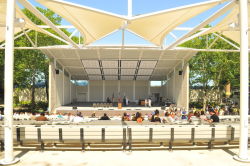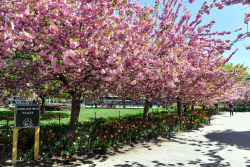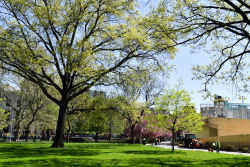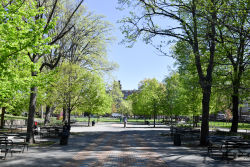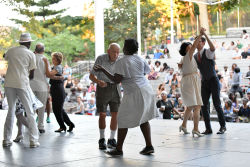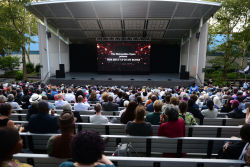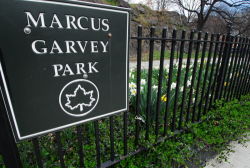Marcus Garvey Park
Mount Morris Fire Watchtower
A prominent feature of Marcus Garvey Park and its neighborhood, the historic Mount Morris Fire Watchtower serves as an important landmark for the Harlem community.
In the 19th century, efforts to contain fire in New York City included the construction of an extensive reservoir system and the Croton Aqueduct, as well as the placement of round-the-clock watchmen at strategic vantage points. These men directed fire companies through an alarm code, corresponding to the severity of the fire and to numbered districts, transmitted by bells, flags and lanterns. City Hall, constructed in 1812 with a bell in its cupola, became the city’s first and main alarm. After a devastating fire in 1835, the Fire Department built dedicated towers across Manhattan.
Ironically, these early structures were made of wood, and fire consumed several of them. Fortunately, fireproof construction became possible in the late 1840s when inventor James Bogardus perfected the use of cast iron as a structural material. The Board of Aldermen commissioned Bogardus to erect the world’s first cast-iron fire watchtower in 1851 on Ninth Avenue at West 33rd Street and a second in 1853 on Spring Street. Two years later, after petitioning by Harlem residents, the City announced a third tower atop Mount Morris. Julius B. Kroehl won the contract with a $2,300 bid (Bogardus wanted $5,750) but followed the pioneer’s design, completing the structure in 1857. Employing then-revolutionary building technology, these early examples of post-and-lintel cast-iron architecture inspired the steel cages developed in the 1880s to support skyscrapers. The Mount Morris watchtower is the only surviving structure of this type.
The 5,000-pound bell in the tower is not the original one. Cast by founders E.A. & G.R. Meneeley of West Troy, NY in 1865, it replaced an earlier bell furnished by Jones & Hitchcock of Troy, NY. Manufacturing flaws may have destroyed the first bell, but it is more likely that improper striking caused the damage. Originally, watchmen struck the bell manually by pulling a lever on the observation deck, one tier above the bell. Some years after the tower was erected, the bell was rung electro-mechanically.
The fire tower network, which at its peak included 11 towers, fell into disuse in the 1870s as the Fire Department began to install telegraphic alarms on street corners and taller buildings rendered these early perches obsolete. At the request of neighbors, however, the Mount Morris tower continued to sound at noon and 9:00 p.m. weekdays, and at 9:00 a.m. and p.m. on Sundays, for timekeeping and churchgoing purposes until about 1909. The Fire Department retained ownership of the tower until 1913.
The Mount Morris Fire Watchtower still stands due to its protected location on parkland. The tower was designated a New York City landmark in 1967 and was listed on the National Register of Historic Places in 1976. Over the years the elements took a toll on the structure, and in 1994 the severely deteriorated tower had to be stabilized. In 2015, as pieces continued to fall off, it was disassembled and placed in storage after the structure was deemed to be “potentially hazardous” and in danger of collapsing. A campaign by the Mt. Morris Park Community Improvement Association and the Marcus Garvey Park Alliance led to a full restoration by the City completed in 2019. In addition to salvaging any sound original ironwork, the project made precise replicas for any replacements, restored the bronze bell and included new structural supports. The landscape around the watchtower was improved and sightlines were opened up so the structure is now more visible to park visitors. Thus, the restored community landmark serves as a continuing reminder of a bygone era.
Check out your park's Vital Signs
Clean & Safe
Green & Resilient
Empowered & Engaged Users
Share your feedback or learn more about how this park is part of a
Vital Park System


